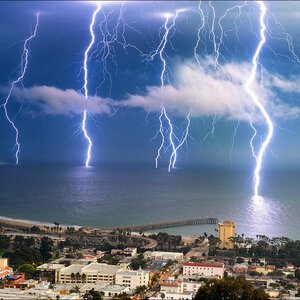Discharge into the water - what happens to fish when lightning strikes the sea
Lightning is an incredible natural phenomenon. If there is bad weather outside, we all try to hide indoors and wait it out. But what do those who have nowhere to hide whose home is the ocean or the sea do? Lightning strikes not only the land areas, but also the water. And what happens to sea creatures at such times?
Lightning + Water
Lightning comes in various voltages, sometimes as high as 50 million volts, and the amperage, sometimes reaching no less incredible numbers up to 100,000 amps. Such figures speak of the destructive power of lightning, capable of destroying everything around. Then a logical question arises - if lightning strikes water bodies, does it kill fish and other creatures that live there?
To begin with, it is worthwhile to understand what happens with water and electricity. In fact, water molecules do not carry current. But there is a sharp change in their properties when it contains all kinds of impurities, in particular salt ions.
If you take pure water, which you can buy at the drugstore, it will be dielectric, because it is distilled and thoroughly purified. But as soon as you pour it on the table, it immediately absorbs particles from the surface and in addition the carbon dioxide in the air. In this case, the electrical conductivity of the water increases.
Dirty water conducts better and more current. During an electric shock, ions that are charged and trapped by the water transfer their charge to it. If you think of seawater, which has a lot of salts dissolved in it and its level of purity is far from ideal, it becomes clear that it conducts current quite well. Yes, seawater contains 3.5% salts. But even that is enough to make it an excellent conductor of current.
What about the fish
When lightning is directed into water, it moves through the water in a different way than it does in the sky - in a thin line. In water, lightning is distributed evenly throughout the sea or body of water. This process makes it look like a hemisphere, which expands in depth. That is, 100 000 Amperes will be dispersed in all directions, and in such a case no special harm will be caused to the sea inhabitants. The most dangerous area is just the epicenter with a radius of 10 meters, no more.
Fish located closer to it can suffer an electric shock and possibly die. But the farther away, the lower the current from the lightning, respectively, the creatures in the water will suffer less if they are not so close to the epicenter. Therefore, in the event of a lightning strike, the total death of all living things in the water will not occur.
Scientists from the United States conducted an experiment concerning the frequency of lightning strikes on land and on water. The results showed that on land it strikes ten times more often. In addition, the instincts of fish and other sea creatures should not be overlooked. They are quite good at sensing storms and other bad weather, and go to the right depth and distance for their own safety.
Sometimes lightning strikes people, but rarely do people manage to escape if the strikes are very strong.
